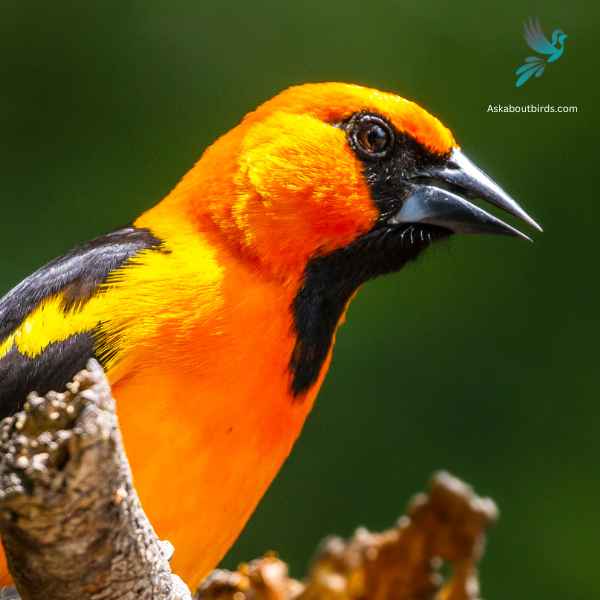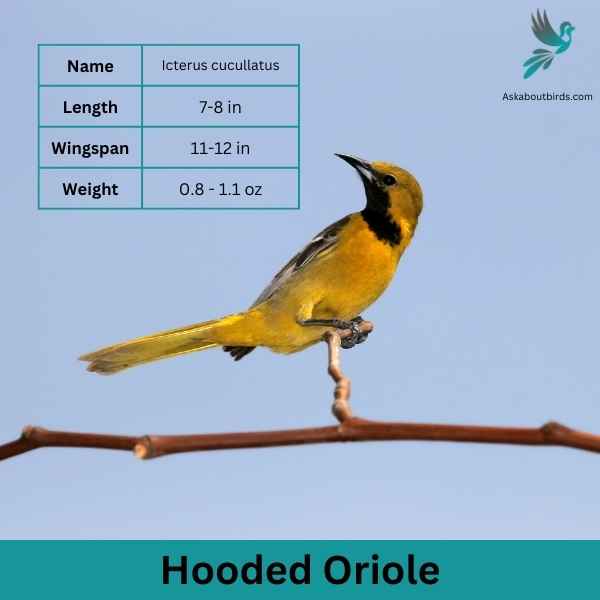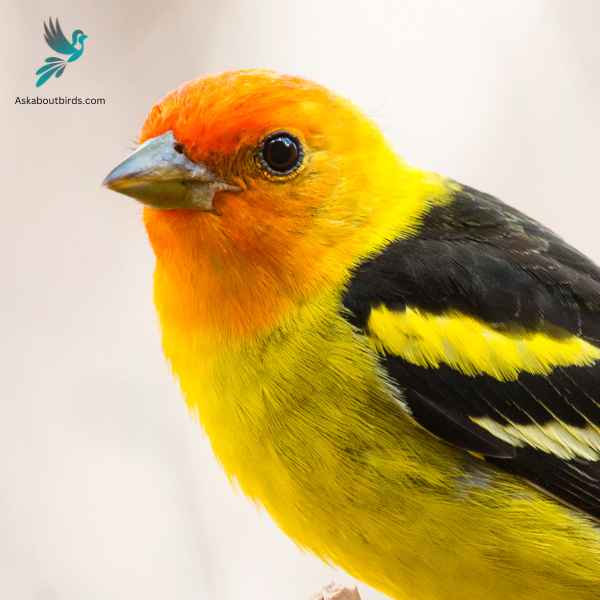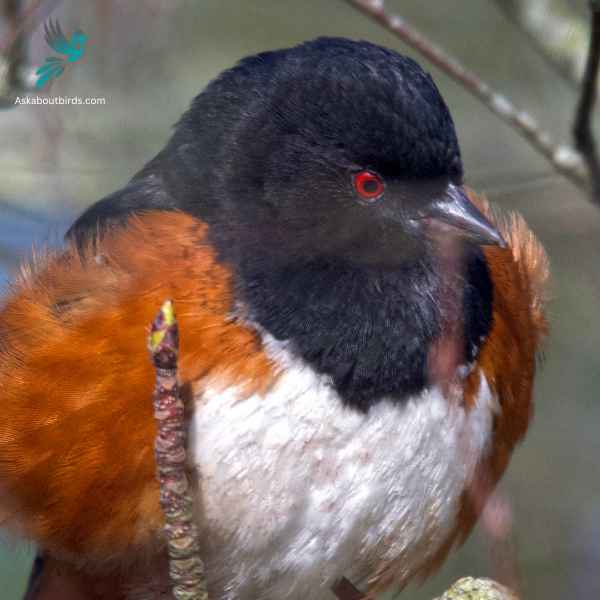Welcome to our guide on the 19 remarkable orange birds that grace the stunning landscapes of Colorado. Embark on a vibrant journey through Colorado’s skies with our free guide, showcasing the 14 most stunning orange-hued birds found in this diverse state.
From subtle orange accents to birds fully dressed in fiery shades, our guide offers a close encounter with these remarkable creatures in their natural habitat. Ready to uncover the beauty of Orange Birds in Colorado?
Let’s explore the vibrant avian world of the Centennial State!
Orange Birds Found In Colorado
Colorado’s wide range of geographical features, from towering mountains to rolling plains and river valleys, provides a diverse array of habitats, attracting a spectacular variety of bird species, each with unique colors and behaviors.
Baltimore Oriole


| Feature | Measurement |
|---|---|
| Scientific Name | Icterus galbula |
| Length | 6.7–8.7 in |
| Wingspan | 9.1–12.6 in |
| Weight | 22.3-42 g |
The Baltimore Oriole is a stunning bird, best known for its vibrant coloration and its rich, whistling song.
Appearance: The male Baltimore Oriole is notable for his bright orange and black plumage and black and white wing bars, a stark contrast to the more muted yellow-brown coloration of the female. Both sexes, however, have long pointed bills and white bars on their wings.
Diet: Baltimore Orioles have a diverse diet that includes insects, fruits, and nectar. Their preference for sweet juices and fruit pulp often brings them to backyard feeders offering oranges and jelly.
Reproduction: The female Baltimore Oriole is responsible for building the distinctive hanging nest, often woven together from fine materials like hair and grass. These nests are usually high in trees to avoid predators. The female lays 3-7 eggs, which are incubated for about two weeks.
Bullock’s Oriole


| Feature | Measurement (Imperial) |
|---|---|
| Scientific Name | Icterus bullockii |
| Length | 7.5-8.5 inches |
| Wingspan | 11.8-12.6 inches |
| Weight | 0.9-1.2 oz |
The Bullock’s Oriole is a bright and lively songbird, known for its stunning contrasting colors and vibrant melodies, predominantly found across the western regions of North America.
Appearance: The male Bullock’s Oriole boasts a brilliant orange chest, belly, and face with a black crown, eye line, throat, and back. Its wings are black with a prominent white patch and white-edged coverts. Females are more muted in coloration, displaying a yellowish-orange hue with grayish-brown wings that still retain the white patches.
Diet: These orioles primarily feed on insects, especially caterpillars, beetles, and grasshoppers. Apart from insects, their diet also includes fruits, berries, and nectar. They’re adept foragers, often hanging upside-down on branches to find hidden prey.
Reproduction: Bullock’s Orioles are noted for their skill in crafting hanging, woven nests, often positioned on the tips of slender branches, ensuring they are difficult for predators to access. Both parents partake in feeding the young, who then fledge about two weeks after hatching.
Hooded Oriole


| Feature | Measurement |
|---|---|
| Scientific Name | Icterus cucullatus |
| Length | 7-8 in |
| Wingspan | 11-12 in |
| Weight | 0.8 – 1.1 oz |
The Hooded Oriole is a brightly colored bird commonly found in the southwestern United States and Mexico, recognized for its vibrant orange-yellow plumage and melodic songs.
Appearance: Males boast a deep orange body contrasted with a black bib, face, and throat, while the wings and tail are predominantly black with white wing bars. Females have a paler, yellow-green appearance, lacking the distinctive hood found in males. Both sexes have long tail feathers and a slightly curved bill.
Diet: The Hooded Oriole’s diet mainly consists of insects, nectar, and fruit. They are especially fond of the nectar from flowers and hummingbird feeders, often competing with hummingbirds for access.
Reproduction: These birds are known to use palm trees for nesting, weaving their nests to the underside of large palm fronds. The nest is a deep pouch, which offers protection to the 3-5 eggs that are typically laid. Both parents share in feeding the young after they hatch.
Western Tanager


| Feature | Measurement |
|---|---|
| Scientific Name | Piranga ludoviciana |
| Length | 6.3-7.5 in |
| Wingspan | 11.5 in |
| Weight | 24-36 g |
The Western Tanager is a vibrant songbird that graces the forests and woodlands of the western regions of North America, enchanting observers with its colorful plumage and melodious song.
Appearance: The male Western Tanager is renowned for its bright yellow body contrasted with a striking red head and black wings and tail. The females are more subdued in hue, primarily being yellow with grayish wings and back, and lacking the brilliant red head of the males.
Diet: Western Tanagers primarily feed on insects, especially when breeding, but they also incorporate a significant amount of fruits and berries into their diet, especially during migration and winter.
Reproduction: Western Tanagers build their nests high in coniferous trees, often well concealed from potential predators. The female usually lays a clutch of 3 to 5 eggs and takes the primary role in incubation, while both parents are involved in feeding the chicks after they hatch.
American Redstart


| Feature | Measurement |
|---|---|
| Scientific Name | Setophaga ruticilla |
| Length | 4.3 to 5.5 in |
| Wingspan | 6.3 to 9.1 in |
| Weight | 8.6 g |
The American Redstart is a lively warbler known for its vivid colors and active hunting style, often seen flitting about, fanning its tail to startle and catch insects.
Appearance: Adult male American Redstarts boast striking black plumage with bright orange patches on the sides, wings, and tail. Females and immature males have grayish-olive upperparts with yellow patches in the same areas where the males display orange.
Diet: American Redstarts are primarily insectivores. They actively forage for flying insects, as well as caterpillars and spiders, often using their colorful tails to startle prey and make them easier to catch.
Reproduction: The female American Redstart builds a cup-shaped nest in the fork of a tree branch. Typically, she lays a clutch of 3 to 5 eggs. The female takes on the primary responsibility of incubating the eggs, while both parents participate in feeding the fledglings after they hatch.
Baltimore Oriole


| Feature | Measurement |
|---|---|
| Scientific Name | Icterus galbula |
| Length | 6.7–8.7 in |
| Wingspan | 9.1–12.6 in |
| Weight | 22.3-42 g |
The Baltimore Oriole is a stunning bird, best known for its vibrant coloration and its rich, whistling song.
Appearance: The male Baltimore Oriole is notable for his bright orange and black plumage and black and white wing bars, a stark contrast to the more muted yellow-brown coloration of the female. Both sexes, however, have long pointed bills and white bars on their wings.
Diet: Baltimore Orioles have a diverse diet that includes insects, fruits, and nectar. Their preference for sweet juices and fruit pulp often brings them to backyard feeders offering oranges and jelly.
Reproduction: The female Baltimore Oriole is responsible for building the distinctive hanging nest, often woven together from fine materials like hair and grass. These nests are usually high in trees to avoid predators. The female lays 3-7 eggs, which are incubated for about two weeks.
Bullock’s Oriole


| Feature | Measurement (Imperial) |
|---|---|
| Scientific Name | Icterus bullockii |
| Length | 7.5-8.5 inches |
| Wingspan | 11.8-12.6 inches |
| Weight | 0.9-1.2 oz |
The Bullock’s Oriole is a bright and lively songbird, known for its stunning contrasting colors and vibrant melodies, predominantly found across the western regions of North America.
Appearance: The male Bullock’s Oriole boasts a brilliant orange chest, belly, and face with a black crown, eye line, throat, and back. Its wings are black with a prominent white patch and white-edged coverts. Females are more muted in coloration, displaying a yellowish-orange hue with grayish-brown wings that still retain the white patches.
Diet: These orioles primarily feed on insects, especially caterpillars, beetles, and grasshoppers. Apart from insects, their diet also includes fruits, berries, and nectar. They’re adept foragers, often hanging upside-down on branches to find hidden prey.
Reproduction: Bullock’s Orioles are noted for their skill in crafting hanging, woven nests, often positioned on the tips of slender branches, ensuring they are difficult for predators to access. Both parents partake in feeding the young, who then fledge about two weeks after hatching.
Western Tanager


| Feature | Measurement |
|---|---|
| Scientific Name | Piranga ludoviciana |
| Length | 6.3-7.5 in |
| Wingspan | 11.5 in |
| Weight | 24-36 g |
The Western Tanager is a vibrant songbird that graces the forests and woodlands of the western regions of North America, enchanting observers with its colorful plumage and melodious song.
Appearance: The male Western Tanager is renowned for its bright yellow body contrasted with a striking red head and black wings and tail. The females are more subdued in hue, primarily being yellow with grayish wings and back, and lacking the brilliant red head of the males.
Diet: Western Tanagers primarily feed on insects, especially when breeding, but they also incorporate a significant amount of fruits and berries into their diet, especially during migration and winter.
Reproduction: Western Tanagers build their nests high in coniferous trees, often well concealed from potential predators. The female usually lays a clutch of 3 to 5 eggs and takes the primary role in incubation, while both parents are involved in feeding the chicks after they hatch.
American Redstart


| Feature | Measurement |
|---|---|
| Scientific Name | Setophaga ruticilla |
| Length | 4.3 to 5.5 in |
| Wingspan | 6.3 to 9.1 in |
| Weight | 8.6 g |
The American Redstart is a lively warbler known for its vivid colors and active hunting style, often seen flitting about, fanning its tail to startle and catch insects.
Appearance: Adult male American Redstarts boast striking black plumage with bright orange patches on the sides, wings, and tail. Females and immature males have grayish-olive upperparts with yellow patches in the same areas where the males display orange.
Diet: American Redstarts are primarily insectivores. They actively forage for flying insects, as well as caterpillars and spiders, often using their colorful tails to startle prey and make them easier to catch.
Reproduction: The female American Redstart builds a cup-shaped nest in the fork of a tree branch. Typically, she lays a clutch of 3 to 5 eggs. The female takes on the primary responsibility of incubating the eggs, while both parents participate in feeding the fledglings after they hatch.
House Finch


| Feature | Measurement |
|---|---|
| Scientific Name | Haemorhous mexicanus |
| Length | 5–6 in |
| Wingspan | 8–10 in |
| Weight | 0.6–0.9 oz |
The House Finch is a small songbird widely distributed across North America and is commonly found in urban and suburban areas.
Appearance: Males of this species are brightly colored with crimson faces and throats, which can extend to the chest and back, while their flanks have streaks. The female is streaked brown and lacks the red coloring. Both have a square-tipped tail and a distinctively long, flat-topped bill.
Diet: House Finches primarily eat seeds, grains, and berries. They have a particular fondness for sunflower seeds and can be commonly seen at bird feeders. Occasionally, they will also consume insects, especially during the breeding season.
Reproduction: House Finches are cavity-nesters and might choose ledges, vents, ledges, and other urban settings. They might also utilize trees or shrubs. Their nests can be made of a wide array of materials, from feathers to twigs.
Rufous Hummingbird


| Feature | Measurement |
|---|---|
| Scientific Name | Selasphorus rufus |
| Length | 3.1–3.9 in |
| Wingspan | 4.3 in |
| Weight | 0.1–0.2 oz |
The Rufous Hummingbird is a small, brilliantly colored bird known for its impressive migratory journeys and feisty behavior.
Appearance: The male Rufous Hummingbird boasts a gleaming orange-red body with a white chest and an iridescent red throat, called a gorget. The female has green upperparts with rufous-washed flanks and tail. Her throat may have some iridescent patches, but it’s generally whitish.
Diet: Like other hummingbirds, the Rufous Hummingbird primarily feeds on nectar from a variety of flowering plants. They also eat insects and spiders for protein, catching them in flight or plucking them from vegetation.
Reproduction: Rufous Hummingbirds nest in trees, shrubs, or even ferns. The female alone selects the site, builds the nest, and cares for the offspring.
Spotted Towhee


| Feature | Measurement |
|---|---|
| Scientific Name | Pipilo maculatus |
| Length | 6.7-8.3 in |
| Wingspan | 11.0 in |
| Weight | 33 g |
The Spotted Towhee is a distinctive songbird commonly found in the shrubby undergrowth and thickets of the western parts of North America. Its song, a series of melodious chirps, often punctuates the early morning air.
Appearance: Male Spotted Towhees showcase a coal-black head, throat, and upper body contrasted with rufous sides and a white belly. Their wings and back are dark but adorned with white spots, hence their name. Females have a similar pattern but are more brownish than black.
Diet: Spotted Towhees primarily feed on a mixture of insects and seeds. They often forage on the ground, scratching through leaf litter to uncover beetles, ants, and other insects, as well as various seeds and berries.
Reproduction: Spotted Towhees usually nest on the ground, concealed by dense vegetation or sometimes in low shrubs. The female builds the nest and lays a clutch of 3 to 5 eggs. She incubates the eggs, while the male stands guard and both parents partake in feeding the fledglings after hatching.
American Robins


| Feature | Measurement |
|---|---|
| Scientific Name | Leptotila plumbeicep |
| Length | 10.6-11.8 in |
| Wingspan | — |
| Weight | 160-200 g |
The American Robin is a widely recognized bird species known for its melodious song and early bird tendencies.
Appearance: American Robins are medium-sized birds with a distinctive appearance. Both males and females sport a gray to brown back and a warm red to orange breast and belly and gray wings. They also have a characteristic white eye-ring and a black head, but males are usually darker than females.
Diet: American Robins have a diverse diet that changes depending on the season. In summer, they feed heavily on earthworms, beetles, and other invertebrates, which they catch on the ground. During winter, they mostly eat fruits and berries.
Reproduction: American Robins usually build their nests in trees or shrubs, but they are also known to nest on human-made structures. The female lays a clutch of about 3 to 5 eggs, which she incubates for about 12 to 14 days.
Where to Spot Colorado’s Orange Birds
Embracing the diversity of Colorado’s landscapes, from snow-capped mountain peaks to sprawling grasslands, one can find an array of avian treasures, particularly the striking orange birds. Here are the top locations in Colorado renowned for their varied and vibrant birdlife:
- Rocky Mountain National Park: Home to over 280 bird species, this park offers an excellent opportunity to spot a variety of orange birds, especially in areas abundant in wildflowers, which attract a multitude of hummingbirds.
- Barr Lake State Park: With its vast lake and cottonwood trees, this park serves as an oasis for migrating birds, making it a birdwatcher’s paradise throughout the year.
- San Juan National Forest: Situated in the southern part of the state, this forest with its varied ecosystems is known to attract a diverse range of bird species, including several with vibrant orange plumage.
- Garden of the Gods: This public park in Colorado Springs, known for its impressive sandstone formations, provides a unique habitat for a wide array of bird species, including several orange varieties.
- Pawnee National Grassland: Located in northeastern Colorado, this grassland is known for its impressive bird diversity. The wide-open spaces make birdwatching a pleasure here.
| Neighboring State | Best Spots for Birdwatching |
|---|---|
| Utah’s Orange Birds | Bear River Migratory Bird Refuge, Antelope Island State Park, Zion National Park |
| Arizona’s Orange Birds | Saguaro National Park, Ramsey Canyon Preserve, Patagonia-Sonoita Creek Preserve |
| New Mexico’s Orange Birds | Bosque del Apache National Wildlife Refuge, Rattlesnake Springs, Bandelier National Monument |
| Oklahoma’s Orange Birds | Wichita Mountains Wildlife Refuge, Oxley Nature Center, Salt Plains National Wildlife Refuge |
| Kansas’s Orange Birds | Cheyenne Bottoms, Quivira National Wildlife Refuge, Flint Hills National Wildlife Refuge |
| Nebraska’s Orange Birds | Fort Niobrara National Wildlife Refuge, Indian Cave State Park, Row Sanctuary |
| Wyoming’s Orange Birds | Yellowstone National Park, National Elk Refuge, Seedskadee National Wildlife Refuge |
FAQs on Orange Bird Species Found in Colorado
What birds in Colorado have orange feathers?
Birds in Colorado that showcase orange feathers often reside near forest edges. The Black-headed Grosbeak is a prime example, boasting bright orange patches against a backdrop of black and white wings. This vibrant combination provides a delightful contrast, making them a standout among Colorado’s diverse bird species.
What kind of bird is orange in color?
In the world of avian species, the Black-headed Grosbeak stands out with its predominantly orange hue. These birds, especially noticeable near forest edges, are adorned with bright orange patches. Their contrasting black and white wings further accentuate their stunning orange coloration, making them a favorite among bird enthusiasts.
What bird is bright yellow-orange in Colorado?
While Colorado is home to various yellow birds, those with a distinctive yellow-orange tint often lead us back to the Black-headed Grosbeak. This bird, besides its bright orange patches, can sometimes exude a greenish-yellow glow, particularly under certain lighting, creating a unique blend of colors.
What bird in Colorado has orange and black feathers?
Among the many feathered residents of Colorado, the black and orange birds that stand out are the Black-headed Grosbeaks. With their brilliant bright orange patches juxtaposed against a mix of black and white wings, they provide a visually striking appearance, making them a memorable sight for those exploring Colorado’s natural habitats.
What distinguishing features do some Colorado birds have in their plumage?
Many birds in Colorado have unique plumage that aids in their identification. A notable feature in some species is the presence of white outer tail feathers. Additionally, several birds exhibit white wing patches which stand out against a backdrop of pale brown, dark brown, or pale gray feathers. Observing these characteristics can assist birdwatchers in differentiating between various species during their outdoor adventures.




